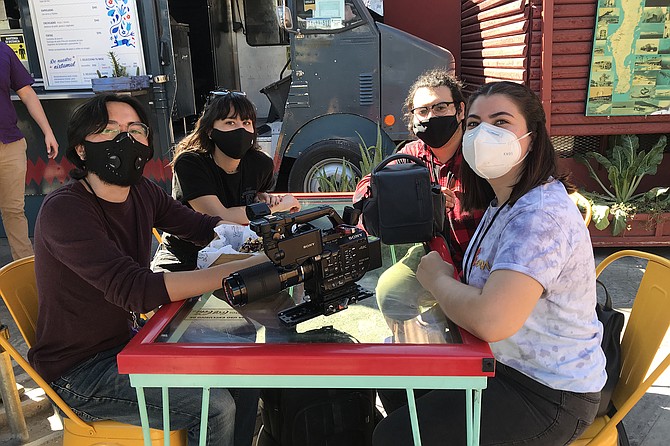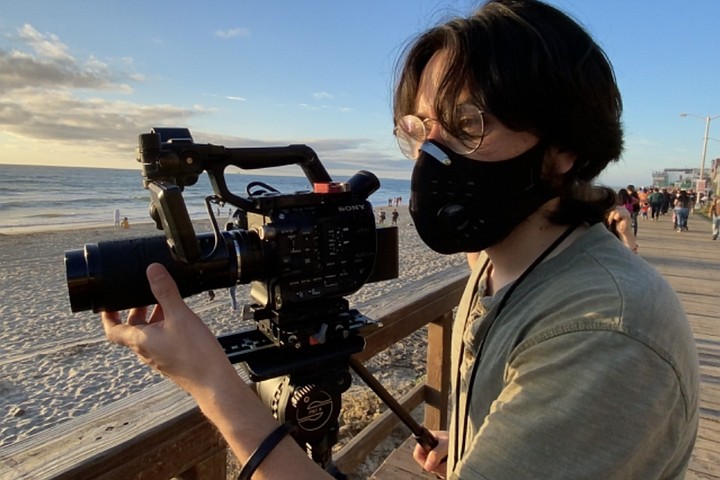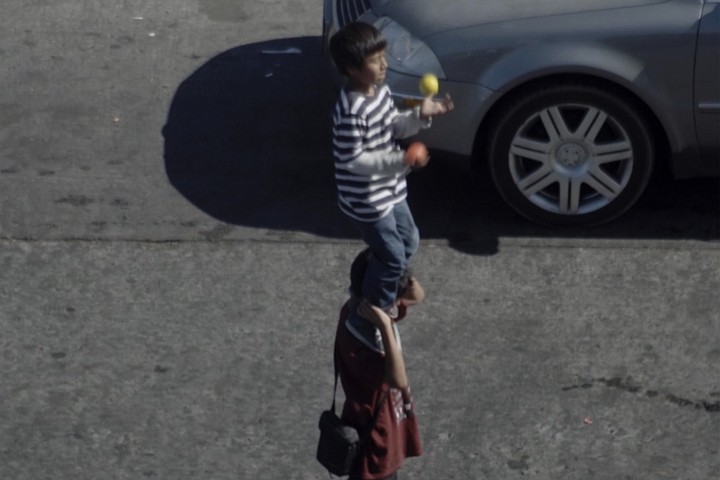 Facebook
Facebook
 X
X
 Instagram
Instagram
 TikTok
TikTok
 Youtube
Youtube

“At 6pm, the police came. They started to kick everyone off the beach. Do it every day. But one man got up and ran. He leaps around the police vehicle, then dives into the water and starts swimming.”
Fausto Celis is telling me this.
“I made this our final shot. It’s a very powerful shot, because it represents what has been going on in Tijuana through these months: that the government can tell you whatever, to wear a mask, not to go out, to leave the beach, to go home. But the people will do whatever they want.”
Celis studies film at the Autonomous University of Baja California, UABC. He and four fellow students have just finished an exhausting documentary schedule. They conceived, shot, and edited together a 10-minute film in four days. Cost: tons of stress, but only $100.

The 100-Hour documentary contest they entered is run by Docs MX out of Mexico City, with international participation. This year, the theme for contestants was “The New Normal.”
I meet Fausto sitting in the morning sun with his team and his Sony 4K XD Cam at a food truck on Tijuana’s Agua Caliente. It’s their first relaxation since delivering their ten-minute baby.
“To do something about truth, especially in these times, which are very uncertain, it’s overwhelming, but at the same time, it’s very rewarding. Because you get to do something that will stay forever in history. I wonder how people will see this time in 2020 in 60 years. Just like we today are talking about things in the ’60s and ’70s. We have made a time capsule, a record.”

Besides, the theme struck home. “For me, when I go out to the streets, when I go out to the markets, when I’m talking to a stranger, I feel fear, just getting near to them. I feel this emotion that unsettles me. And I wanted to represent that visually, to see how people behave in a market, at a bus stop, in a restaurant. Because as we’re getting more used to having a mask, whatever, we’re letting go of the responsibilities we have in this pandemic, washing our hands, keeping our distance. So I tried to convey these [feelings and fears] visually. It’s a very visual film. It shows you a day in the life of the city of Tijuana. We went to very common places. We saw people coughing, not wearing masks, not keeping their social distancing, doing things which you question. I mean, after six months or more, is it that they’re tired of the pandemic? Of the consequences, of the numbers of deaths?
“This documentary is not very traditional. It doesn’t have someone talking to the camera and showing you images about their daily life. What I’m looking for is something more about feelings, emotions. I want the audience to feel the pressure, to feel the paranoia, to feel the fear.
“On our two-day shoot, we saw a lot, I mean a lot, of people in the streets. You question, why? But of course, they’re not there just because they want to have fun. They are people who are working. Not everybody has the privilege of staying home. Eighty percent of the people here have to go out, earn a living day by day by selling things in the streets, by selling food. That is the purpose of this whole documentary: that we have to get out of this bubble we live in, and see beyond our houses, see beyond our towns.
“So it was a lot of observation, staying in a corner, watching the flow of the whole city. I’ve traveled to a lot of cities in Mexico, and you don’t get this kind of movement of people in other cities. With Tijuana, you get the border, you get immigration, you just get constant crowds.
“And we wanted to be loyal to the real soundtrack. If we were on a street, we wanted to hear the street. We didn’t want to saturate it much. Because the city itself is very saturated. You don’t need to add a lot of sounds, music, because the city itself has its own musicality.”
Fausto may be in a unique position to shoot this film. His mother is Mexican, his stepfather is American, and he spent first five months of the pandemic in the US. “I was in LA, where my parents live. So I kind of saw it from your side of the story.”
So did he gain a new perspective on his hometown from making the film? “Yes. Yes I did. I have lived here in TJ 19 years of my life, and I’m still learning things. Making this doc took me places that I didn’t want to see, to be honest. We just want to look the other way. We don’t want to look at the problems. Because life is hard enough. But we need to start doing it. We need to have empathy. That’s where I think Tijuana is lacking sometimes. Empathy and humility, because we get lost in our own ego.
“We were shooting the border crossing between San Ysidro and Tijuana. You do get used to it when you are crossing every weekend. Like, we filmed young kids standing on each other’s shoulders, juggling, dancing for people waiting in the line. Working! Six, eight years old. And then you contrast that when you go to Avenida Revolución, where you see kids [playing] on the zebra donkeys. It’s the contrast. Kids trying to earn a living and others enjoying the privileges. I’ve seen the border since I was four years old. I’ve always seen it, but not seen it. But now, making this $100 film, you sense the power. The contrast that you can make, the juxtaposition between one image and another, that can cause emotion. Like we jump from the kids juggling on the border to the kid getting his picture taken, enjoying himself on the donkey on Revolución. It’s very powerful, it’s very sad. As a 22-year-old person learning to make films, I question myself: what can I do? You have to help to make things better, right? I don’t have that answer right now, but I’ll be looking for it for years to come.”


“At 6pm, the police came. They started to kick everyone off the beach. Do it every day. But one man got up and ran. He leaps around the police vehicle, then dives into the water and starts swimming.”
Fausto Celis is telling me this.
“I made this our final shot. It’s a very powerful shot, because it represents what has been going on in Tijuana through these months: that the government can tell you whatever, to wear a mask, not to go out, to leave the beach, to go home. But the people will do whatever they want.”
Celis studies film at the Autonomous University of Baja California, UABC. He and four fellow students have just finished an exhausting documentary schedule. They conceived, shot, and edited together a 10-minute film in four days. Cost: tons of stress, but only $100.

The 100-Hour documentary contest they entered is run by Docs MX out of Mexico City, with international participation. This year, the theme for contestants was “The New Normal.”
I meet Fausto sitting in the morning sun with his team and his Sony 4K XD Cam at a food truck on Tijuana’s Agua Caliente. It’s their first relaxation since delivering their ten-minute baby.
“To do something about truth, especially in these times, which are very uncertain, it’s overwhelming, but at the same time, it’s very rewarding. Because you get to do something that will stay forever in history. I wonder how people will see this time in 2020 in 60 years. Just like we today are talking about things in the ’60s and ’70s. We have made a time capsule, a record.”

Besides, the theme struck home. “For me, when I go out to the streets, when I go out to the markets, when I’m talking to a stranger, I feel fear, just getting near to them. I feel this emotion that unsettles me. And I wanted to represent that visually, to see how people behave in a market, at a bus stop, in a restaurant. Because as we’re getting more used to having a mask, whatever, we’re letting go of the responsibilities we have in this pandemic, washing our hands, keeping our distance. So I tried to convey these [feelings and fears] visually. It’s a very visual film. It shows you a day in the life of the city of Tijuana. We went to very common places. We saw people coughing, not wearing masks, not keeping their social distancing, doing things which you question. I mean, after six months or more, is it that they’re tired of the pandemic? Of the consequences, of the numbers of deaths?
“This documentary is not very traditional. It doesn’t have someone talking to the camera and showing you images about their daily life. What I’m looking for is something more about feelings, emotions. I want the audience to feel the pressure, to feel the paranoia, to feel the fear.
“On our two-day shoot, we saw a lot, I mean a lot, of people in the streets. You question, why? But of course, they’re not there just because they want to have fun. They are people who are working. Not everybody has the privilege of staying home. Eighty percent of the people here have to go out, earn a living day by day by selling things in the streets, by selling food. That is the purpose of this whole documentary: that we have to get out of this bubble we live in, and see beyond our houses, see beyond our towns.
“So it was a lot of observation, staying in a corner, watching the flow of the whole city. I’ve traveled to a lot of cities in Mexico, and you don’t get this kind of movement of people in other cities. With Tijuana, you get the border, you get immigration, you just get constant crowds.
“And we wanted to be loyal to the real soundtrack. If we were on a street, we wanted to hear the street. We didn’t want to saturate it much. Because the city itself is very saturated. You don’t need to add a lot of sounds, music, because the city itself has its own musicality.”
Fausto may be in a unique position to shoot this film. His mother is Mexican, his stepfather is American, and he spent first five months of the pandemic in the US. “I was in LA, where my parents live. So I kind of saw it from your side of the story.”
So did he gain a new perspective on his hometown from making the film? “Yes. Yes I did. I have lived here in TJ 19 years of my life, and I’m still learning things. Making this doc took me places that I didn’t want to see, to be honest. We just want to look the other way. We don’t want to look at the problems. Because life is hard enough. But we need to start doing it. We need to have empathy. That’s where I think Tijuana is lacking sometimes. Empathy and humility, because we get lost in our own ego.
“We were shooting the border crossing between San Ysidro and Tijuana. You do get used to it when you are crossing every weekend. Like, we filmed young kids standing on each other’s shoulders, juggling, dancing for people waiting in the line. Working! Six, eight years old. And then you contrast that when you go to Avenida Revolución, where you see kids [playing] on the zebra donkeys. It’s the contrast. Kids trying to earn a living and others enjoying the privileges. I’ve seen the border since I was four years old. I’ve always seen it, but not seen it. But now, making this $100 film, you sense the power. The contrast that you can make, the juxtaposition between one image and another, that can cause emotion. Like we jump from the kids juggling on the border to the kid getting his picture taken, enjoying himself on the donkey on Revolución. It’s very powerful, it’s very sad. As a 22-year-old person learning to make films, I question myself: what can I do? You have to help to make things better, right? I don’t have that answer right now, but I’ll be looking for it for years to come.”
Comments